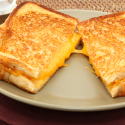Cooked bread and cheese is an ancient food, according to food historians, popular across the world in many cultures; evidence indicates that in the U.S., the modern version of the grilled cheese sandwich originated in the 1920s when inexpensive sliced bread and American cheese became easily available. The so-called cheese dream became popular in the United States of America during the Great Depression.
It was originally made as an open sandwich, but the top slice of bread became common by the 1960s.U.S. government cookbooks describe Navy cooks broiling “American cheese filling sandwiches” during World War II. Many versions of the grilled cheese sandwich can now be found on restaurant menus across the United States and internationally.
A grilled cheese sandwich is assembled and then heated until the bread crisps and the cheese melts, sometimes combined with an additional ingredient such as bacon, tomatoes or onions. Several different methods of heating the sandwich are used, depending on the region and personal preference. Common methods include being cooked on a griddle, grilled, fried in a pan or made in a panini grill or sandwich toaster (this method is more common in the United Kingdom where the sandwiches are normally called “toasted sandwiches” or “toasties” and in Australia where they are called “jaffles”). A clothes iron has also been utilized to make a grilled cheese in a pinch, as in a hotel room where there are no other cooking appliances.
When making grilled cheese on an open griddle or pan, one side is cooked first, then the sandwich is flipped and cooked on the other side. The sandwich is finished when both sides are toasted and the cheese has melted. Butter, oil, or mayonnaise may first be spread on either the bread or the cooking surface in the case of butter and oil. An alternative technique is to toast or grill each half of the sandwich separately, then combine them. Another method sometimes referred as an “inside out” grilled cheese has an extra layer of cheese put on the outside of each side and cooked, causing the cheese to caramelize into a crispy outer layer.
When using butter best results are achieved at a medium heat. This prevents the milk solids in butter from burning and allows sufficient time for heat to thoroughly penetrate the sandwich and melt the cheese without burning the bread. A crispy golden-brown crust with a melted cheese center is a commonly preferred level of preparedness. Cooking times can vary depending on pan dimensions, ability to control the intensity of the heat source, bread type, cheese variety and overall thickness of pre-cooked sandwich.
Source: Wikipedia




